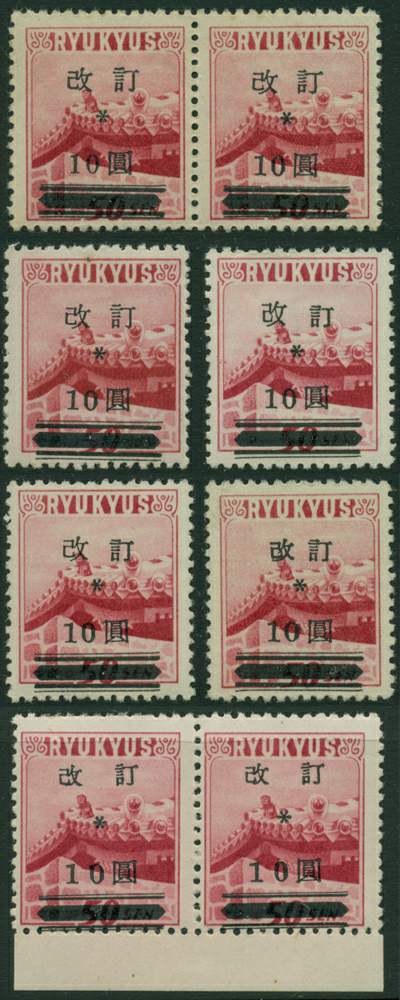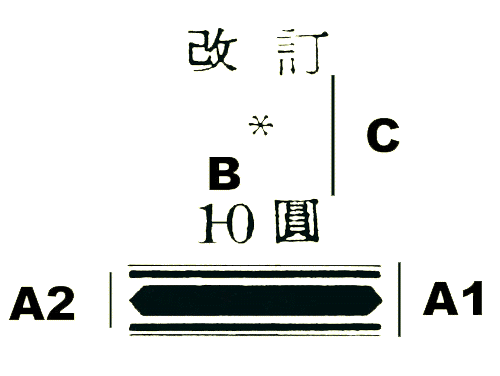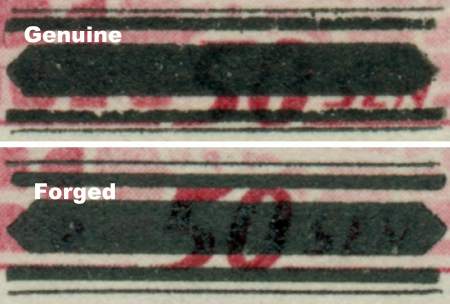George C. Baxley
| |||||||||||||||||||||||||||||||||||||||||||||||||||||||||||||||||||||||||
| |
|
||||
| Wide Bars | |||||
| Narrow Bars | |||||
| Wide "10" | |||||
| Wide Bars | |||||
| Narrow Bars | |||||
| Wide "10" | |||||
|
Distance Between: A1 - Outside of the Top and Bottom Thin Bars. A2 - Inside of the Inner Thick Bars. B - "1" and "0" using the Vertical Stroke of the 1. C - Bottom of the "Tei" and highest point on the Yen character. |
|||||
* Inner bar measurements are from the bottom of the upper thick bar to the top of the lower thick bar.
General Discussion of Forged Overprints, Scott 16 Series.
While well known counterfeits (to defraud the Postal Agency) of Scott 16 had been recognized for years (aka Gushikawa forgery/counterfeit - two types), it was not until December of 1973 that forgeries (to defraud the stamp collector) of mint stamps of the Scott 16 series surfaced. These stamps were sold by a "certain" but unnamed United States dealer to the Sun Philatelic Center in Tokyo and ended up in the hands of Dr. Yoshimi Ito who quickly recognized that these "New Type 10 Yen Overprint" stamps were not genuine despite the excellent printing quality and ink color "not much different" from the three genuine printings. Dr. Ito actually concluded that on the "New" 16s, as he called them, the printing quality was "better" than the genuine stamps.
The original cachet of "New" 16s obtained by Dr. Ito is discussed and recorded in detail in From The Dragon's Den, Volume 6, No. 3, October 1974, at pages 57-65. This holding contained 140 copies of the forgery. Of this amount, there were eight blocks of 8. Dr Ito was able to plate the stamps against the basic stamp, Scott 8. He concluded that the stamps were manufactured in vertical units of 8 (2 across by 4 down). Seven blocks of 8 in the holding, along with a block of 7, a block of 5 and a block of 4, accounted for the vast majority of the stamps in rows 3-10 of a sheet of 100 of Scott 8, the basic stamp that was overprinted. He believed that rows 1-2 were forged in blocks of 4.
Dr. Ito's study demonstrated that the forgeries consisted of 8 different overprint settings.
The forger was obviously well aware of three basic printings, as well as the type fonts used on them, as there was an effort to replicate the characteristics of these on the forged stamps.
Numbering the stamps across and down you find:
Mimics 1 (a) 1st printing (Scott 16A) 2 (b) 1st printing (Scott 16A) 3 (c) 2nd printing (Scott 16) 4 (d) 2nd printing (Scott 16) 5 (e) 2nd printing (Scott 16) 6 (f) 2nd printing (Scott 16) 7 (g) 3rd printing (Scott 16B) 8 (h) 3rd printing (Scott 16B)
I find very little in the philatelic literature about these forgeries since the initial report in 1974. In From The Dragon's Den, Volume 14, No. 2, April 1982, there is a comprehensive catalogue of the 16 series is provided. The article concludes with comments regarding forgeries in these terms:
A small number of good quality forgeries, printed in block of eight stamps, in which all three printings are depicted (two of the FIRST, four of the SECOND, and two of the THIRD; 2x4) were discovered in 1973. (FTDD, 14:2, at page 61)
This article also noted the Gushikawa counterfeits (type I and II) and good quality forgeries of 16Bb (Kai omitted) and others of a supposed inverted surcharge are known."
The forgeries were again noted in From The Dragon's Den, Volume 15, No. 2, April 1983, at pages 43-44 by Dr. Robert Weiner. In an article titled "The 10y on 50s Kai Tei Provisional Issue of 1952 (Part 2)," Dr. Weiner discussed the forgeries previously reported by Dr. Ito. Dr. Weiner described these as a "dangerous forgery."
In distinguishing items a-f, from genuine stamps Dr. Weiner focused on the "reversed 5" of the Kai and it's relationship to the diagonal stroke that normally sweeps under it.
In this article, Dr. Weiner's descriptions were not illustrated by close-ups of the stamps. He did provide a picture of a reconstructed block of 8 but because of the size it is hard to relate his comments to the particular stamp. Below I have provided detail pictures of each stamp, with my descriptions of the key points on the forged stamps. These are the exact stamps that formed the basis of Dr. Weiner's article.
Detailed Illustrated Discussion of the Eight Recorded Forged Overprints.
Reversed "5" () in Genuine 16 & 16A
Forgeries Mimicking Scott 16A (First Printing, narrow spaced bars)Stroke arches under and stops "near" left border of reverse "5" Both fonts found on second printing (16) & first printing (16A)
(a) Short diagonal stroke stops at & touches bottom of inside vertical stroke of reversed 5 Long diagonal stroke stops before arching under the reversed 5Forgeries Mimicking Scott 16 (Second Printing, wide spaced bars)(b) Short diagonal stroke stops at & touches bottom of inside vertical stroke of reversed 5 Long diagonal stroke arches under approximately 40% of bottom of reversed 5
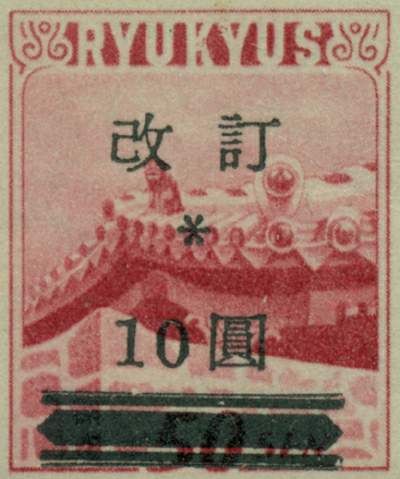 (c) Short diagonal stroke stops at & touches bottom of inside vertical stroke of reversed 5 Long diagonal stroke arches under approximately 40% of bottom of reversed 5Forgeries Mimicking Scott 16B (Third Printing) Reversed "5" (
(c) Short diagonal stroke stops at & touches bottom of inside vertical stroke of reversed 5 Long diagonal stroke arches under approximately 40% of bottom of reversed 5Forgeries Mimicking Scott 16B (Third Printing) Reversed "5" ((d) Short diagonal stroke extends into the gap & touches bottom of inside vertical stroke of reversed 5 Long diagonal stroke arches under approximately 70% of bottom of reversed 5
(e) Short diagonal stroke stops at & touches bottom of inside vertical stroke of reversed 5 Long diagonal stroke arches under approximately 40% of bottom of reversed 5
(f) Short diagonal stroke extends far into the gap & touches bottom of inside vertical stroke of reversed 5 Long diagonal stroke arches under approximately 95% of bottom of reversed 5
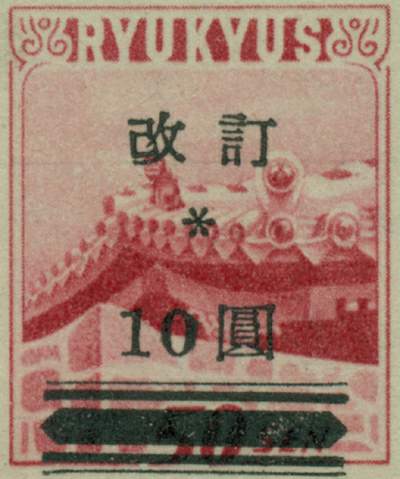
) in Genuine 16B
Stroke arches under and stops approximately 30% the way under the bottom of the reversed 5. (g) Short diagonal stroke stops at & touches bottom of inside vertical stroke of reversed 5 Long diagonal stroke joins the bottom of the reversed 5. Copy examined had ink offset on the gum which is not a characteristic of the genuine stamps.
(h) Short diagonal stroke stops at & touches bottom of inside vertical stroke of reversed 5 Long diagonal stroke joins the bottom of the reversed 5. Copy examined had ink offset on the gum which is not a characteristic of the genuine stamps.
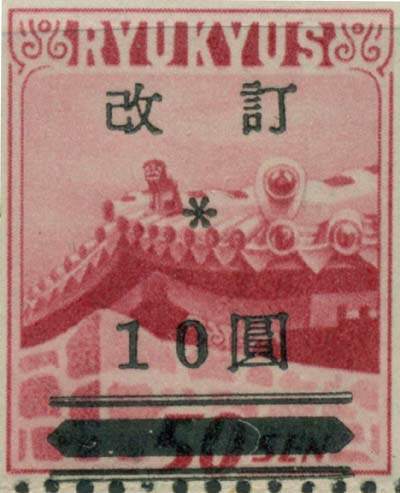
Proposed Methodology for Reviewing Stamps for Forgeries.
Based upon the recorded information (above), the following 16 series stamps are not suspect:
- Any multiple of 16 or 16A or 16B that contains 3 or more stamps horizontally.
Based upon the recorded information (above), the following 16s fail the giggle test (ie you laugh when you see them) and are forged:
- Any vertical strip of 4 which contains a 16A, a pair of 16s and a 16B.
- Any vertical pair or vertical strip of stamps that contains a 16 (wide spaced bars, narrow spaced "10") immediately above a 16B (wide spaced "10"). Note that in a sheet of 100 of the genuine 16 there are no variety stamps with a wide spaced "10." While there is such a stamp in a sheet of 16A, in the forged overprints that stamp (16A) is separated by the 16s between the 16B.
Based upon the recorded information (above), the following 16s are most likely forged:
- Any vertical pair or strip that contains a 16A (narrow bars) and a 16 (wide spaced bars). Note that Scott 16, positions 11,12,13, sometimes have narrow spaced bottom bars and that Scott 16A, position 86, contains wide spaced bottom bars.
- Any stamp where the short diagonal stroke of the "Kai" touches the bottom of inside vertical stroke of reversed 5
and the where the long diagonal stroke that sweeps under the reversed 5 does not pass under 70%-80% of it.
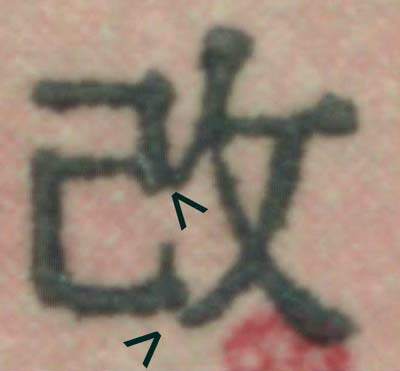
[a through h] - Any stamp where the long diagonal stroke of the "Kai" touches the bottom of inside vertical stroke of reversed 5.
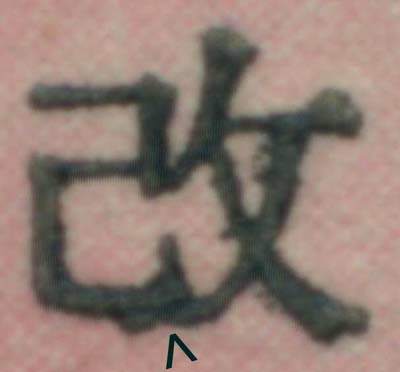
[a (stops short), g & h]
Characteristics of Ink on Forged 16s. On the eight forgeries that I have examined, the ink appears lighter and more translucent/transparent than on genuine copies. While this may not be consistent across all forgeries, it is a factor to consider. With a focus on the large center bar, the forgeries allow you to see more of the underlying stamp than the genuine overprints.
Quantities of the Forgeries.
Absent a confession by the forger, we will probably never know the quantities of these forged stamps that were created or entered the market. Dr. Ito worked with a holding of 140. Out of this holding he was able to plate 72 of the stamps against a sheet (100 stamps) of Scott 8. This means that the remaining 68 were duplicative or did not have identifiable spots or blurs that would allow plating. Because no information on the positions of the remaining 68 stamps is discussed, it is not possible to determine how many sheets the holding of 140 can be traced to. The number of sheets involved would have been helpful in establishing the quantity of stamps forged.
When Were These Forgeries Produced?
All we know for certain is they were produced in 1973 or earlier. I am aware of no published research on the stamps that would help in dating them. Unlike the Gushikawa counterfeits, they do not appear canceled.
| Scott 16 | Scott 16A | Scott 16B | Scott 16,16A,16B |
|---|---|---|---|
| Second Printing | First Printing | Third Printing | All Three Printings |
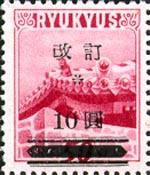 |
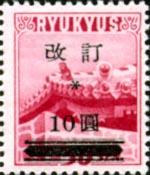 |
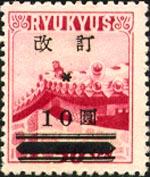 |
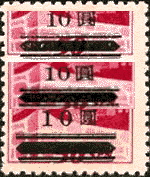 |
|
Forgeries Discovered in 1973 |
|||
George C. Baxley, PO Box 807, Alamogordo, NM 88311
|
|
|
|
|
